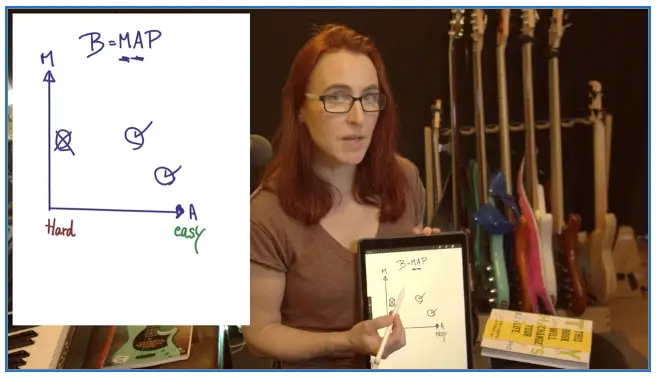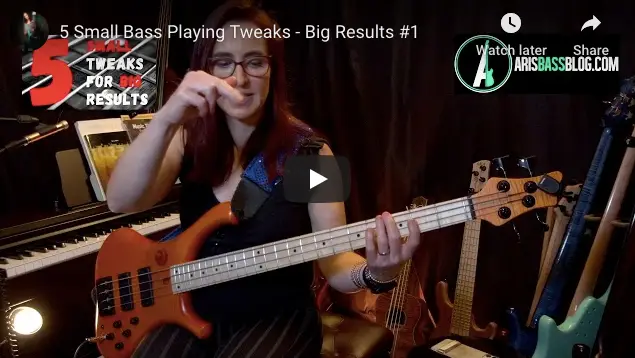You Got a Friend in me [UBass solo • VIDEO]
My Little UBass Friend and I have a Little Note for you…
Enjoy!
Thank you Kala, for creating amazing instruments that are highly addictive and impossible to put down!
More Kala UBass renditions: Fun groove!
Me and Magnus Sjoquist: U2 stands for: 2 UBasses
Giveaway of a Kala UBass (not current – should we do another one like it?)
How the Pros Use Inversions
How the Pros Use Inversions
A student recently asked me:
“I’m not 100% sure I get the necessity of inversions… I understand them, but when I’m playing and I need a third or a fifth, I just think of the note I need and then go up or down, which doesn’t require the extra calculation of the inversion interval… What am I missing?”
You say you “need a third or a fifth”. The crucial considerations are: do you mean the interval from your starting note and is it ascending or descending? Or are you referring to the third or fifth of a chord or scale? For example, an ascending fifth from C is G. A descending fifth from C is F. However, when you refer to the fifth as a chord tone or scale degree, in C major this will be a G regardless of whether you ascend or descend. So when you “go down” (to use your phrase) from the C to the scale’s G below, that C and G you are playing form the interval of a fourth, not a fifth (even though it is the fifth scale degree in C). So, you may be closer than you think to “getting inversions” but lost in confusion about some crucial aspects.
One such aspect is to mistake interval inversions (fourths and fifths are inversions of each other for example!) with ascending and descending intervals.
In the example above, if you do what you say correctly, you just think of the note you need and hit it either above or below the root! By doing that you actually are calculating/playing the inversions. You play a fifth ascending and a descending fourth, or, to use your other example, you play an ascending third or a descending sixth and both of those will lead you to the same note, just in different octaves.
My guess is this is what you mean: You’re playing a Bossa groove, for example, with two bars of a C chord. So you start with the root and fifth of the C chord to create your groove and to switch things up sometimes you play the G above and sometimes the G below the C. You are playing the chord tone of the fifth, in this case G. The intervals you play are an ascending fifth or a descending fourth.
In this sense it’s absolutely crucial to understand inversions. Many theory books I checked are painfully incomplete about this. They talk of C and G and then G is a fifth whether you play it ascending or descending. That is only true if you assume C major as the key. In other words, giving the correct context is important to avoid confusion. If for example the key were G major, then C to G means playing from the fourth to the tonic. Some people are sloppy with this stuff and if you don’t understand it 100%, it will come back to bite you later.
Watch the video to learn more!
Why you need to know inversions as a bassist
- The shape of the hand playing an interval is key. Kinesthetic knowing (feeling/muscle memory) is always much faster than conceptual knowing.
- Transposing: If you know the right note in both directions (ascending and descending from the root) as a shape, you have a much easier time transposing!
- [my favorite reason:] Ears! The sounds of the inversions are related (check out my Ear Confidence Course for more info here!):
- seconds and sevenths: tense
- fourths and fifths: open
- thirds and sixths: sweet, romantic, pretty
- Chord inversions. Makes it much faster to grasp those if you know your interval inversions
- If you run out of strings or frets at any point, it helps to find the right note quickly
- Fourths and fifths are easy. But make sure you have this down for thirds and sixths (major and minor), plus seconds and sevenths (major and minor of course), as well.
- As the basic building blocks of music, having a good handle on intervals is a must. Once we get into symmetric scales, extensions, alterations, melodic minor and harmonic minor and their modes – you can’t afford to have to think hard or know things in one key only (typically in the key of C)
Famous Inversion
“I wish” by Stevie Wonder shows off:
- major sixths and minor thirds are inversions of each other (Ebm)
- major thirds and minor sixths are inversions of each other (Ab)

[Side Note: The chord changes in the verses are Ebmin to Ab7, so I notated the key signature as Db major (Eb dorian).]
Watch how using the inversion creates a cool variation and makes the groove a two bar phrase (even though the notes stay the same).
Musical Effects of Intervals
One secret that even some pros don’t fully realize, is that the inversion of intervals spans a different width of intervallic space. Using the “I Wish” example: an ascending minor third is a rather small interval. Compare that to the descending major sixth which is a much bigger jump and therefore covers a wider space. The effect of the bigger jump is more dramatic. Use with taste and to fine tune the musical effect you want to create!
If your bass line goes into a higher range because you have a jump in there and it could interfere with other elements of the arrangement, you can keep the selection of your notes and strategically reverse some interval jumps to stay in the lower range.
All About Inversions and more…
Not motivated to practice? Try this! [3 minute video]
Behavior Model [My Homework for a Course]
There is a formula for changing your behavior. Professor BJ Fogg of the Stanford Behavior Design Lab developed it (he is also the creator of Tiny Habits™. As part of my training, we had to record ourselves teaching it. Let me know what you think… this is highly applicable for designing effective practicing habits!
So what do you do if motivation is low?
The model holds the answer:
the harder something is to do the more motivation it takes to do it.
And then, the opposite is also true:
if something is easier to do you need less motivational muscle to do it.
How can you do that for your bass practice?
- Have the bass out of its case (easy entry)
- Work with “prompts” or “anchors” as described in the Tiny Habits Method book
- Pick a short, easy exercise, like one scale. Do it. And then celebrate.
Why do I have to celebrate? It was just a scale, that doesn’t even count!
Because creating a good feeling is what creates habits.
Not repetition.
Not 21 days. You can create a “cookie at 3PM habit” in one sitting. You give a teenager a smartphone and watch the habit form instantly.
It is the bit of “celebrating” that we miss.
Likely your internal voices are dismissing all of the above by saying things like:
- I cannot just make myself “feel good” if I am not indeed feeling it!
- If I just start with one silly scale how do I get to ever be able to play TeenTown?
- This is ridiculous, one scale fffft. If I start celebrating THAT I am cheating myself out of ever practicing for real.
Not so fast. Professor Fogg has answers for all of these in his book.
The Tiny Habit® method works if you follow it verbatim. What’s the risk of trying something new?
For me, it was an absolute life-changing game changer.
Don’t forget to celebrate!
Ari
Here are a few other Tiny Habits videos on practicing music and an interview Professor Fogg did with me.
Why Just Keep Playing is not Working
May I Have Two Minutes of Your Time?
More on Practicing, Technique and Music Theory here:
Killer Octave Riff! [VIDEO]
Killer Octave Riff
Turn a simple 2-chord progression into something special using a modern take on a “disco-inspired” octave groove. This killer riff is also great for shedding your technique: Challenging string crossings, a varied rhythmic pattern, and a relatively quick tempo… enjoy!
I’ll go step by step to break it down for you starting with the rhythm using dead notes. Then I add the pitches – and finally octaves – as you get more comfortable with the string jumps. I’ll show you practical fingerings and lots of tips to get you grooving this riff.
- Tip #1: Stay relaxed and maintain quiet hands.
- Tip #2: “Go slow – slower – to go fast!”.
- Tips #3 and #4: …check out the video!
Download the PDF for the Killer Octave Riff here
Click here to check out the episode on notreble.
Bass used is a Marleaux Consat five string
Five Small Bass Playing Tweaks for Instant Results
Five Small Bass Playing Tweaks for Instant Results
From years of teaching, I have identified several small adjustments you can make in your playing and practicing that will make a big difference instantly. In this mini-series, I walk you through five such jewels. All five of these tips – whether technique related or practice strategy related – will give your tone and playing an instant boost. Let me know what you think!
Welcome
Tweak #1
This is probably the tip I give bass players the most. Just by making this small adjustment, you gain speed and dexterity while working less and getting a beefier tone.
Tweak #2
Your back, neck, and arms will most certainly thank me for this one…
Tweak #3
If you have seen me talk about bass for more than five minutes, you likely heard me talk about this wicked habit that can slow you down and take much of the fun out of playing.
Tweak #4
If you heed this advice when using this very common practice tool you will do yourself (and your bandmates!) a huge favor!
Tweak #5
If you practice backward, your progress will run backward, too. Eliminate this common practicing error and accelerate your progress in the right direction!










